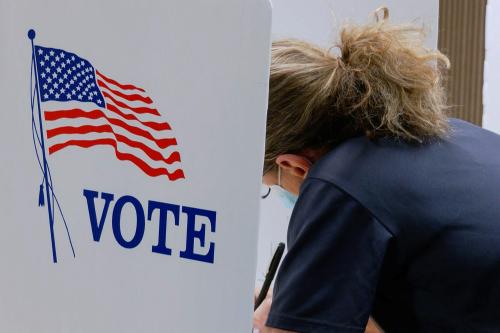Editor’s note: Recent innovations—the Internet, social platforms, and mobile devices—have upended how we receive, consume, share, and interpret the news. In this FixGov series, experts weigh in on the challenges facing the industry and discuss possible ways to enhance news coverage and improve media capacity. On May 19,
senior fellow E.J. Dionne will convene a panel of top experts
and practitioners to discuss how to fix the problems facing America’s Fourth Estate.
The annual anticipation surrounding the announcement of the Pulitzer Prizes has, in recent years, been joined by a new journalistic custom: elegiac reflections on how the profession has changed, accompanied by grim harbingers of what’s to come. This year, Pulitzer announcements were soon followed by reports that two winners from mid-size papers have since left those outlets for jobs in public relations. And they’re hardly outliers: Outside of a handful of giant cities, one out of every four reporting jobs in the U.S. has disappeared over the last decade. “If you want a reporting job today,” The Washington Post recently put it, “your best bet is to move to D.C., L.A. or New York.”
Sound career advice though it may be, this represents a disturbing future—not only for journalists, but the citizens they serve. Consider the stories which might not have been written if some of this year’s winners had left the industry a year or two earlier: Natalie Caula Hauff was part of a team that found links between South Carolina’s lax domestic abuse laws and the deaths of over 300 women in the last decade. Rob Kuznia worked with two other journalists to expose massive corruption in California’s impoverished Centinela Valley Union High School District—leading to an FBI investigation. Every reporter and editor who leaves the industry represents a snuffed opportunity for stories like these to come to light.
What can be done about this problem? A key problem is finding a replacement for advertising revenue, which has collapsed as a funding model. Between 2005 and 2013, according to the Pew Research Center, print and online advertising revenue taken in by newspapers fell by almost two-thirds. Attempts to reclaim some of this revenue have grown so desperate that even organizations like The New York Times now feature “native advertising” (or “sponsored content”), which trades on a publication’s credibility by running ad copy designed to resemble a normal article. This ethically questionable practice weakens important barriers between the business and editorial sides of publications, but in this new market, risky practices are likely to become standard practice. As Martin Baron, executive editor of the Washington Post, said in a recent speech: “Advertisers are looking for innovative, measurable, and successful ways to connect with potential customers. Without abandoning our principles of independent and honest coverage, newsrooms must participate in creating products that appeal to advertisers, boost readership, and deliver satisfying results for both.” In other words, newsrooms of the future will be more subject to the interests of advertisers, and not even powerful national outlets will be immune. The pressure on smaller publications may be even more intense.
If even national outlets are this vulnerable to financial pressures, there’s reason to doubt whether they can compensate for the decline in media capacity brought about by the closure of smaller outlets. It is true that major digital outlets like BuzzFeed, Vox, and the Huffington Post have expanded their reporting staffs. But it’s unrealistic to think that they’re capable of filling that gap, or that they’re designed to do so. Politico may be the exception that proves the rule: It recently announced plans to increase coverage of state politics by expanding into New Jersey and Florida, with more states to follow. Yet as its announcement made clear, Politico plans to “leverage our state-based reporters to write stories for a national audience.”
National sources, then, may patch some gaps, but more alternatives are needed. Nonprofit news organizations can play a role, but a recent Knight Foundation report warns that “few appear to be rapidly approaching a sustainable business model”—they’re still too dependent on foundation funding. Many publications have started to seek revenue by hosting partner events and creating enhanced perks for loyal readers.
Many industry figures find this approach promising, but it’s hard not to be struck by the establishment of a tiered membership structure among the subscriber base. If nothing else, it’s a dismal illustration of how even the community that gathers around a publication can now be commodified. Perhaps what would most help struggling publications—and the American press in general—is a broader base of paid subscribers, not a small set of elite club members. Social norms around media consumption have changed in calamitous ways, and if the industry is to survive, they may need to change again. Readers, to put it bluntly, must once again become subscribers. If this seems a distant prospect, it’s worth asking: Is it any less of a long shot than everything else the industry is trying? And what would it take to convince readers that the news is a worthy investment?



Commentary
Improving media capacity: To save print media, focus on readership not ownership
May 15, 2015